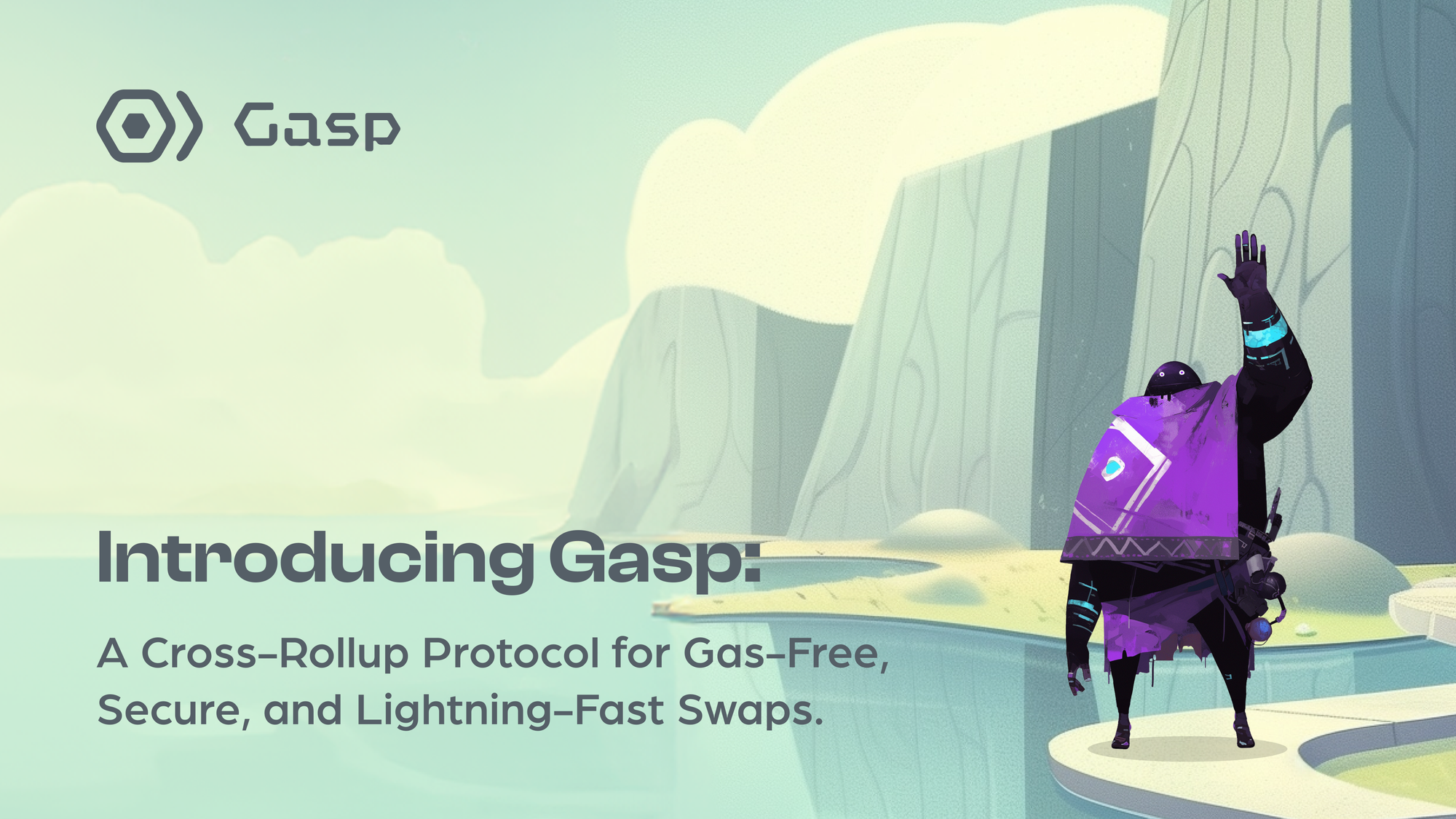Introducing Gasp

With Gasp, a cross-rollup protocol designed for exchanging cryptocurrencies between blockchains (including L2s), we are launching a cross-chain communication platform that can scale with large amounts of capital and high-speed trading for enterprise and individual retail users alike.
This blog post is a deep dive into Gasp’s gas-free, secure, and lighting-fast swaps for cross-chain transactions.
In this article, we will explore the impact of Gasp’s core tech stack and ideas, how it’s all implemented, and how Gasp is reshaping cross-rollup transactions.
A Native Cross-Chain Protocol vs a Bridge
Several cross-rollup bridges already exist across the Ethereum landscape. The problem with these existing solutions is that they are faulty.
Bridges often rely on centralized authorities, introducing trust and security issues. They also frequently require wrapped tokens, which add extra steps and complexity to the user experience.
Gasp, by comparison, is a blockchain implemented as a Layer 2 (L2) on Ethereum using EigenLayer restaked security. The network's operations are censorship resistant, prioritizing security, self-custody, and guarantee of liquidity withdrawal through Gasp's escape hatch mechanism, and it functions without any trusted intermediaries.
The GASP token powers the Gasp network, facilitating exchange transactions within the Gasp network through staking. This ensures that the Gasp network always remains operational and censorship-resistant, while also determining transaction throughput. The larger a user's GASP stake, the more transaction throughput they will unlock within the Gasp network.
As a native cross-rollup protocol, Gasp facilitates gas-free, MEV-protected, and lightning-fast cross-rollup swaps. The protocol does this by leveraging advanced technologies such as escape hatches, ZK proofs, and decentralized sequencers.
What makes Gasp’s approach special is that it ensures trustless transactions through decentralized mechanisms, enhancing security and reducing risks compared to protocols with centralized single points of failure and other traditional bridge mechanisms. Gasp also eliminates the need for wrapped tokens.
We built Gasp's native cross-rollup protocol to address what we saw as major gaps in cross-chain transactions (mentioned above). We did this to give enterprise users, web3 developers, and investors alike the best possible solution for their cross-rollup transactions. To offer the most seamless and efficient cross-rollup communication process, we designed a platform with features that include: cross-chain liquidity pools and vaults, EigenLayer security, gas-free transactions, a ferry mechanism for immediate fund transfers, and MEV protection to prevent front running and sandwich attacks. (These features are explored in greater detail in the "How Gasp Works" section below).
Why Gasp is Building on EigenLayer and Ethereum
The initial expression of Gasp’s cross-chain vision was Mangata. There, we used the Substrate technology — a native blockchain development framework — that allowed us to develop Mangata as an appchain with the sole purpose of validating cross-chain transactions. However, Gasp required several adjustments to make a backend work on Ethereum. The new Gasp protocol still uses Substrate technology because of its application-specific chain benefits. This allows for a focused validation protocol that enables features like native swaps, high speed, and gas free transactions that generic smart contract frameworks cannot provide. Gasp also leverages EigenLayer for fast and secure transaction finality (more on this below).
Mangata-era community members will also be taken care of on the new Gasp protocol. We recently announced a 3% airdrop of GASP to MGX testnet-era holders, and we are currently exploring how we can shift LP providers from Mangata to Gasp, with a further 4% of GASP’s token supply reserved for early community building incentives.
How Gasp Works
When a cross-chain swap is performed with Gasp, several features and components work seamlessly in the background:
- Cross-chain Liquidity Pools and Vaults
- Gasp maintains liquidity pools (LPs) on both sides of each swap, ensuring that they are available to perform transactions.
- The vaults strategically allocate liquidity to various pools, maximizing returns while maintaining sufficient liquidity for user transactions. This system ensures efficient, reliable swaps with minimal slippage or transaction delays.
- EigenLayer Security — Gasp uses EigenLayer to ensure transaction finality through the power of Ethereum crypto-economic security. In doing so, EigenLayer provides a unified security framework that enhances the reliability and trustworthiness of cross-chain transactions. Gasp leverages EigenLayer's decentralized security, making it more robust than protocols relying solely on native staking mechanisms.
- Gas-Free Transactions — Gasp's application-specific chain architecture allows it to avoid the double charging typical in other protocols, providing gas-free swaps. (More on fees in the next section.)
- Ferry Mechanism — When a user initiates a deposit on one blockchain, a ferry — typically an independent actor or liquidity provider — observes this transaction and takes on the risk of advancing the equivalent amount on the target blockchain before the deposit is fully confirmed. The involvement of "ferries" ensures faster finality by taking on the risk of transaction validity, allowing for immediate fund transfers.
- MEV Protection — Gasp's MEV protection eliminates the power imbalance that allows the possibility of reordering and censoring transactions in traditional blockchain architectures. MEV isn’t possible on transactions happening through Gasp because no malicious actor can scan the mempool and reorder them to front run or sandwich other transactions. Gasp employs a unique method of hiding transaction details until the point of execution, making it significantly harder for malicious actors to predict and exploit transaction patterns. This advanced randomized ordering protection mechanism safeguards users from common MEV attacks, such as front-running and sandwich attacks, ensuring a more secure and equitable trading environment.
Gasp's best option for guaranteeing the protocol’s crypto economic security for the ecosystem was to rely on Ethereum via EigenLayer. Now, Gasp can offer enterprise-level security to retail users with native swaps.
This setup has its own set of trade-offs:
- Gasp users are required to hold Gasp tokens in their wallet, which enables them to perform more swaps the more tokens are held
- Depending on the moment of the transaction and the chains that are being used, exchange fees might surpass the gas cost.
However, they are the foundations for the most high-frequency trading, big size, omnichain, cross-chain stablecoin arbitrage-ready architecture in the market.
How Gasp Achieves Gas-Free Swaps
Gasp limits excessive fees for users. While there is a 0.3% exchange commission fee, Gasp does not include fees for gas, MEV, or other hidden costs — simplifying cost calculations and keeping things clear for users.
How does Gasp achieve this? On Gasp, blockchain users and automated market makers (AMM) users are part of a single, combined product instead of one product deployed atop another product, each with its own business model. In this way, Gasp can offer gas-free transactions to its users.
The 0.3% exchange commission fee finances network maintenance and incentivizes liquidity providers to promote a healthy trading environment.
Integrating a New Chain into Gasp
The process for integrating a new chain into Gasp varies. For EVM chains, the process begins with the necessary smart contracts being deployed on both the new chain and the Gasp ecosystem through the Ethereum Virtual Machine, facilitating communication between the chains and ensuring that transactions are securely recorded and verified.
While the deposit and withdrawal process is the same as Ethereum, EVMs must include an added verification module. When Arbitrum is integrated with Gasp, the process will be mostly smooth for other EVM chains.
Each chain integrating with Gasp should also have its own unique network ID set on the Gasp chain, which is a question of one governance-made transaction.
Sequencers are responsible for reading and validating transactions from the new chain. To maintain security and integrity, at least one honest sequencer must be controlled by Gasp, which reads the initial state from the new chain and verifies subsequent transactions, preventing fraudulent activities.
When integrating other EVM chains and verifying cross-chain transactions, Gasp must also verify EigenLayer signatures to securely move aggregated public signatures of EigenLayer operators or even a list of EigenLayer operators. This can be costly, which is why we are moving to aggregated signatures as a more cost-efficient solution.
Integrating non-EVM chains such as Solana, Tron, or Cosmos requires additional work to verify EigenLayer signatures and ensure smooth operation.
Gasp Community and Start Building
Whether you’re a big DeFi player, regular user, or crypto degen, we encourage you to join the Gasp community. There are opportunities to support the network, offer liquidity, and help grow the Gasp ecosystem for a more interoperable and scalable web3 experience.
We also just launched Gasp Natives: The Explorer, a journey into the Gasp universe. It’s a token of thanks to everyone who has so far taken part in the Gasp testnet. If you haven’t already joined, there is still time to participate.
Official Links
- Website: https://www.gasp.xyz/
- Testnet: http://holesky.gasp.xyz/
- X (Twitter): https://twitter.com/gasp_xyz
- Discord: https://discord.gg/gasp-xyz

